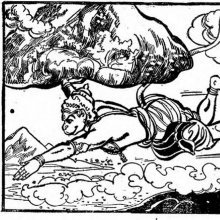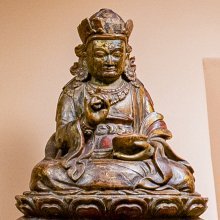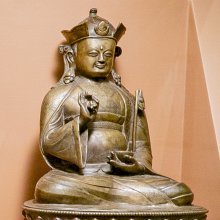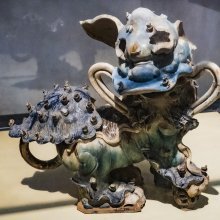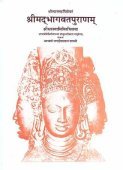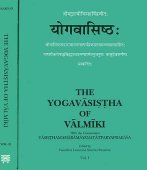Supernatural power, Supernormal power, Magical power: 2 definitions
Introduction:
Supernatural power means something in Buddhism, Pali, Hinduism, Sanskrit. If you want to know the exact meaning, history, etymology or English translation of this term then check out the descriptions on this page. Add your comment or reference to a book if you want to contribute to this summary article.
Images (photo gallery)
In Hinduism
Yoga (school of philosophy)
Source: ORA: Amanaska (king of all yogas): A Critical Edition and Annotated Translation by Jason BirchSupernatural Powers are denoted by the Sanskrit term Siddhi, according to the Amanaska Yoga treatise dealing with meditation, absorption, yogic powers and liberation.—Accordingly, as Īśvara says to Vāmadeva: “Thought, intellect and ego are the officiants; mind is the Soma-drinking sacrificer, and it sacrifices the senses and ten vital breaths into the orb of light. [This] orb of light shines from the root [of the palate] to the aperture [at the top of the head]. It is to be meditated on constantly by yogins [because] it bestows the eight supernatural powers (aṣṭa-siddhi) such as minimisation [aṇimādyaṣṭasiddhidam]. [...]”.

Yoga is originally considered a branch of Hindu philosophy (astika), but both ancient and modern Yoga combine the physical, mental and spiritual. Yoga teaches various physical techniques also known as āsanas (postures), used for various purposes (eg., meditation, contemplation, relaxation).
In Buddhism
Tibetan Buddhism (Vajrayana or tantric Buddhism)
Source: Google Books: The Crystal Mirror of Philosophical Systems1) Supernormal Powers were developed by certain Hermits who where thereafter called “Seers”. Also see the “Five Supernormal Powers” (in Tibetan: mngon shes lnga).—Accordingly, [during the time of king Saṃmata or Mahāsammata]: Some hermits reduced their desires and achieved satisfaction; sitting alone, they isolated mind and body and so attained tranquil abiding. When they then gained supernormal and magical powers [e.g., various physical powers], they were called “seers”. Of those, many who had attained supernormal powers and trained in logic analyzed their own minds, set forth a path for attaining liberation and higher rebirth, and wrote texts that laid out the logical reasons proving that path. It was through this that the philosophical systems of the extremists spread. The first to arise was the Sāṃkhya. During the period of measureless lifespans there lived a seer called Kapila (“Yellow-White”), who had long yellow-white hair and possessed the five supernormal powers. Relying on his innate wisdom, he composed many texts. His followers were known as Sāṃkhyas (“Enumerators”) or Kāpilīyas.
2) Supernormal power (in Tibetan: mngon shes; Sanskrit: abhijñā) — Powers attained by advanced meditators: retrocognition, clairvoyance, clairaudience, telepathy, yogic achievements, and knowledge of the destruction of the corruptions, i.e., delusions. The first five can be gained through deep concentration, and are not specific to Buddhism; the last is unique to Buddhists and is attained only on the basis of superior insight into the nature of reality

Tibetan Buddhism includes schools such as Nyingma, Kadampa, Kagyu and Gelug. Their primary canon of literature is divided in two broad categories: The Kangyur, which consists of Buddha’s words, and the Tengyur, which includes commentaries from various sources. Esotericism and tantra techniques (vajrayāna) are collected indepently.
See also (Relevant definitions)
Partial matches: Magic, Power, Supernormal.
Query error!
Full-text (+823): Riddhi, Siddhi, Siddha, Ashtasiddhi, Mahasiddhi, Prakamya, Riddhyabhijna, Riddhipada, Iddhi, Yogamaya, Divyacakshu, Riddhibala, Dasabala, Abhijina, Srishtipattana, Yogagamin, Hike, Vashitva, Yatrakamavasaya, Raddha.
Relevant text
Search found 261 books and stories containing Supernatural power, Magical power, Magic power, Magic powers, Supernormal power, Supernatural powers, Supernormal powers; (plurals include: Supernatural powers, Magical powers, Magic powers, Magic powerses, Supernormal powers, Supernatural powerses, Supernormal powerses). You can also click to the full overview containing English textual excerpts. Below are direct links for the most relevant articles:
Kathasaritsagara (cultural study) (by S. W. Chitale)
Magic in ancient India < [Chapter 4 - Social Conditions]
Description of Minor Deities in the Kathasaritsagara < [Chapter 5 - Religion and Philosophy]
Traces of Mysticism in Jainism (Study) (by Sadhvi Madhystha Prabha)
1. Introduction (spirituality and supernatural powers) < [Chapter 5 - Mysticism at the level of Body and Mind]
2. Meaning and Definition (of supernatural powers) < [Chapter 5 - Mysticism at the level of Body and Mind]
5.2. Mental Labdhi (attainments) < [Chapter 5 - Mysticism at the level of Body and Mind]
Puranic encyclopaedia (by Vettam Mani)
Yoga-sutras (Ancient and Modern Interpretations) (by Makarand Gopal Newalkar)
Sūtra 4.1 < [Book IV - Kaivalya-pāda]
Siddhis—Supernormal powers < [Book III - Vibhūti-pāda]
Sūtra 3.15 < [Book III - Vibhūti-pāda]
Dhammapada (Illustrated) (by Ven. Weagoda Sarada Maha Thero)
Verse 382 - The Story of the Novice Monk Sumana who Performed a Miracle < [Chapter 25 - Bhikkhu Vagga (The Monk)]
Verse 175 - The Story of Thirty Monks < [Chapter 13 - Loka Vagga (World)]
Verse 25 - The Story of Cūlapanthaka < [Chapter 2 - Appamāda Vagga (Heedfulness)]
Maha Buddhavamsa—The Great Chronicle of Buddhas (by Ven. Mingun Sayadaw)
Biography (11) Yasodharā Therī < [Chapter 44 - Life Histories of Bhikkhunī Arahats]
Biography (25): Dabba Mahāthera < [Chapter 43 - Forty-one Arahat-Mahatheras and their Respective Etadagga titles]
Discourse on Kuṇāla Jātaka < [Chapter 22 - Founding of Vesali]
Related products
